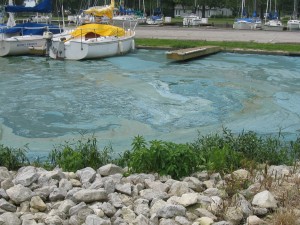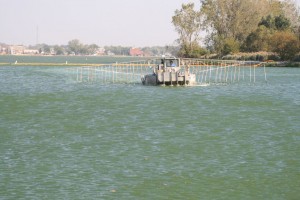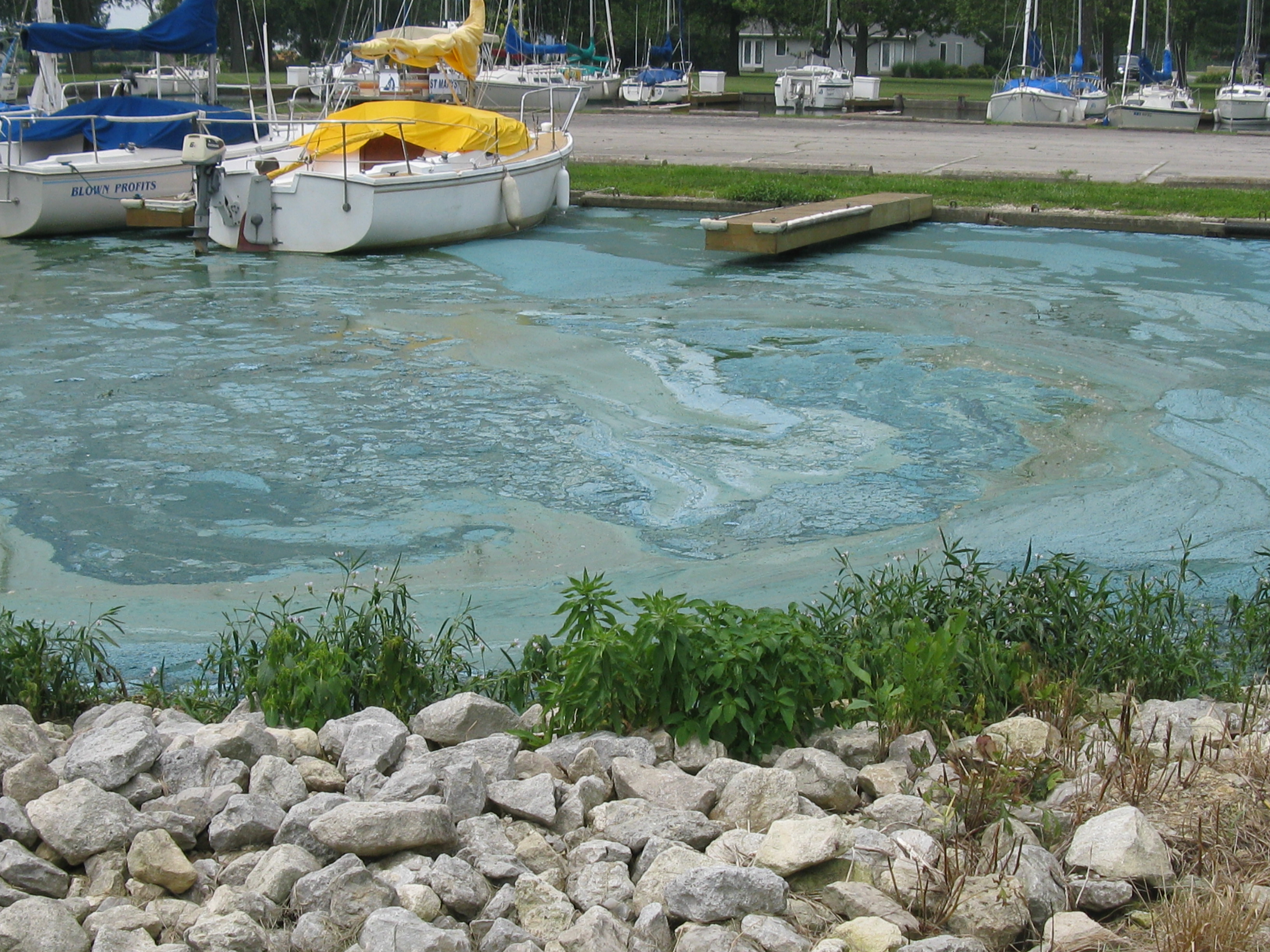A popular recreational lake in western Ohio has nearly died, economically and environmentally, because of algae thriving on runoff from farm fields, officials say.

Algae chokes a marina in Grand Lake St. Marys. Image: Ohio Environmental Protection Agency
Grand Lake St. Marys is now undergoing a clean up to get rid of toxic algae. The cause is mainly a wet spring causing manure from nearby fields to flow into the lake.
As a part of the $3.4 million operation, the lake will be treated with nearly 2.6 million gallons of the chemical compound alum, state officials said in a news release.
Cleaning lakes with alum has been carried out for over a few hundred lakes in the US, but none of those lakes were as large as the 13,000-acre Grand Lake St. Marys — Ohio’s largest inland lake.
Alum captures phosphorus and sinks it so the algae can’t feed on it. This prevents blooms -accumulation of algal populations- from forming. It also ends the phosphorus supply to the algae already present. It sinks along with the bound phosphorus.
The original plan was to treat the whole lake, said Dina Pierce, spokesperson for the Ohio Environmental Protection Agency. Due to this year’s wet weather, however, the algae came on early and the plan was scaled back. Instead, just the 4,900-acre center of the lake, with the highest concentration of algae, will be treated. Treating the edges of the lake will not help or hinder it greatly. Attacking only the center, however, will help the overall health of the lake, she said.

Map: Rachael Gleason
While this will not completely heal the lake, it will reduce the algae.
Uncooperative weather prevented the execution of the whole project this year; picking it up next year depends upon funding and active groups involved with the project, said Pierce.
Excessive algae is produced by excessive nutrients. When soil cannot absorb more water, the additional water carries nutrients — in this case manure – into waterways.
The harmful algal blooms closed boating and fishing over the past two years, said John Kessler, assistant chief for the Division of Soil and Water Resources at the Ohio Department of Natural Resources.
Direct contact with these algal blooms or even just breathing water droplets from such an infected lake can make humans and animals sick.
The US Environmental Protection Agency discovered the blue-green algae — known as cyanobacteria — during a 2007 national survey, said Pierce.
The microcystin level, the toxic product of blue-green algae, was high enough to make people sick, she said.
Eighty- five percent of the phosphorus in the lake comes from farmland where manure has been applied, said Tim Lovett, president of the Lake Improvement Association, which is involved with the clean-up of Grand Lake St. Marys. The organization provides financial and public support to the Lake Restoration Commission. That group partnered with the Environmental Protection Agency and the Ohio Department of Natural Resources working toward cleaning the lake.
The land that drains to the lake has the most farm animals in Ohio and perhaps the country, Lovett said.

Testing to see if alum will successfully remove phosphorus from the water. Image: Ohio Environmental Protection Agency
The watershed is fairly small but everything from it, including the large livestock population waste, drains into Grand Lake St. Marys, said Pierce.
“Last year’s late winter and wet spring caused a lot of run-off,” said Pierce, “The hot dry summer is perfect for blue-green algae.”
“The bloom last year was unlike anything anyone had seen,” said Pierce.
It killed tourism, which is a major source of economy in that area, dampened the economy and led to few corporations running out of business, she said.
Besides adding alum to the lake to get rid of phosphorus, another temporary fix being carried out is removing sediment-containing phosphorus from the lake, Lovett said.
The Ohio Environmental Protection Agency put out an advisory for the first time in 2009, warning people about the toxic algae in the lake. The Grand Lake St. Marys is the first lake in the country where an advisory for toxic algal blooms has been released. Advisories for roughly 20 lakes, including Lake Erie in Ohio were released last year. While individuals were warned about the presence of toxic algae in all the lakes, Grand Lake St. Marys and the lake around Blue Rock State Park in Ohio were considered most dangerous.
The Ohio Environmental Protection Agency has a list of current harmful algal bloom advisories for lakes in Ohio along with other information about toxic algae, on their website for the publics use.

Algae in East Beach, one of the three state beaches at Grand Lake St. Marys. Image: Ohio Environmental Protection Agency
“Even if we cut off the external sources, there is enough phosphorus to keep the algae blooming,” said Pierce, “It took decades for the lake to get this bad; people understand it will take more than a year to fix it.”
“Local people are being very supportive. They’ve been hit, banded together and are trying to change practices,” she said.
The farming community is working hard to get the nutrient amount under control, said Kessler.
Manure is treated chemically to remove phosphorus before it is spread onto fields, said Lovett.
The Natural Resources Conservation Service is helping farmers get involved in making improvements, said Pierce.
The lake can be clean once again, said Kessler. People just need to be more careful about their practices.
Listen to an account of runaway algae returning to Lake Erie and read about it here.
